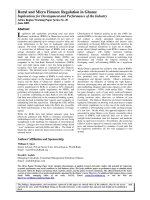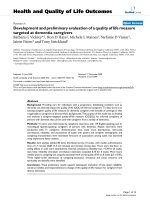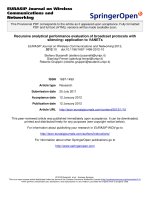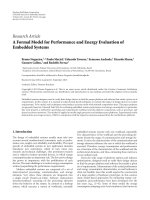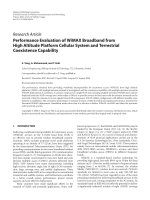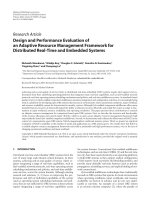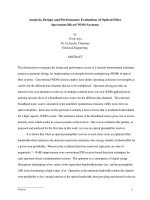Development and performance evaluation of low HP tractor operated wiper sprayer
Bạn đang xem bản rút gọn của tài liệu. Xem và tải ngay bản đầy đủ của tài liệu tại đây (701.16 KB, 12 trang )
Int.J.Curr.Microbiol.App.Sci (2018) 7(11): 3484-3495
International Journal of Current Microbiology and Applied Sciences
ISSN: 2319-7706 Volume 7 Number 11 (2018)
Journal homepage:
Original Research Article
/>
Development and Performance Evaluation of Low HP Tractor
Operated Wiper Sprayer
A. Udaybhaskar*, K.V.S. Ramireddy, A. Ashok Kumar and B. V. S. Prasad
Department of FMPE, College of Agricultural Engineering, Bapatla, ANGRAU, AP, India
*Corresponding author
ABSTRACT
Keywords
Wiper sprayer,
Spray, Chemical
protection and cost
economics
Article Info
Accepted:
04 October 2018
Available Online:
10 November 2018
World crop yields are reducing every year between 20 to 40% due to the damage wrought
by plant pests and diseases. Crop protection is essential to reduce loses of yield. Among all
the crop protection methods, chemical protection usage growing effectively as of its
immediate action, low cost and reduces human drudgery. Chemical protection of crop
carried out by dust or spray form. To spray pesticides on crop, low hp tractor operated
wiper sprayer was developed instead of using conventional equipment to reduce operating
cost, time and drudgery. In laboratory condition, uniformity coefficient of developed wiper
sprayer was found to be 89.9 %. The average effective field capacity, field efficiency, fuel
consumption and application rate of developed wiper sprayer in the field of groundnut was
found to be 0.9072, 1.4899, 2.0618 ha h-1, 80, 78.83, 77.92%, 1.513, 1.018, 0.815 l ha-1
and 423, 253, 181 l ha-1 at forward speeds of 1.5, 2.5 and 3.5 km h-1. Cost economics of
developed wiper sprayer was found to be 310.2, 197.61 and 150 Rs. ha -1 at forward speeds
of 1.5, 2.5 and 3.5 km h-1.Saving of labor cost (%) and time (%) over conventional method
of spraying found to be 101.5, 216.27, 316.67 % and 1714, 2880, 4023 % at forward
speeds of 1.5, 2.5 and 3.5 km h-1. Operating speed of 3.5 km h-1 was given best
performance.
Introduction
Crop yields are reducing every year by pests
and disease. Crop protection is essential to
reduce loses of yield. At present, the plant
protection methods are chemical, mechanical,
biological, agronomical and biophysical types.
Among these, most preferable one is chemical
method of plant protection. India has a large
and diverse agricultural sector which requires
quite effective methods for spraying pesticides
at a desired rate, in minimal time for reducing
yield losses. Chemical protection plays a
major role in agricultural production because
of effective control of pest, disease and weed
with minimal time and expenditure. It also
reduces the number of labours requirement in
the field and reduces human drudgery.
Chemical protection is carried out by applying
pesticides on crop by sprayers. The main
function of sprayer is to atomize the spray
fluid and distribute them uniformly over the
crop to be protected. Another function is to
regulate the amount of pesticides to avoid
excessive application that might prove
harmful or wasteful. Spraying techniques are
3484
Int.J.Curr.Microbiol.App.Sci (2018) 7(11): 3484-3495
classified as high volume (>400 l ha-1), low
volume (5-400 l ha-1) and ultra-low volume
(<5 l ha-1), according to the total volume of
liquid applied per unit of ground area. Farmers
generally use lever operated knapsack sprayer,
power operated knapsack sprayer, power
sprayer and boom sprayer for spraying of
pesticides. Knapsack sprayers consist of two
adjustable straps for carrying the 10-20 litters
tank which may result in back pain. Due to
low tank capacity of knapsack sprayer, one
person covers less area of land about 0.4 ha
day-1 (Ojha and Michael, 2016). Lever
operated knapsack sprayer requires constant
pumping which results in muscular disorder
and also cannot maintain desired uniform
pressure resulting in an inadequate spraying
over the crops.
used for fabrication of machine to minimize
manufacturing cost. Strength of material under
the influence of load will help the operator to
increase life of the machine (Mada et al.,
2013). Design characteristics of various
components of developed wiper sprayer are
described under the following sections.
Chemical tank
To develop wiper sprayer, tank was chosen by
specifications of mini tractor VST Shakti MT
180 D as its available space rear side and
width. Tank is made up of mild steel and its
capacity is 210 l, its dimensions are 900×600
mm. Line diagram of chemical tank is show in
figure 1.
Main frame and hitch system
India is a land of agriculture which comprises
of marginal, small, medium and large farmers.
In this, marginal and small land holdings
contribute 67.10 and 17.91 % for agriculture.
In marginal and small holdings, low horse
power tractors ranging 18-22 hp are getting
popular in India than the large tractors.
Development of compactable equipment to
low horse power tractors was needed.By
considering
problems
with
existing
machinery, increasing popularity of small
tractors among the marginal and small farmers
and to reduce the labour requirement, there is
a need for development of low HP tractor
operated wiper sprayer.
Keeping the above points in view, the
objectives of the present investigation was
under taken to develop, evaluate performance
and cost economics of wiper sprayer.
Materials and Methods
Wiper sprayer was developed at Department
of Farm Machinery and Power Engineering,
College of Agricultural engineering, Bapatla,
ANGRAU. Locally available material was
The material used for fabrication of the frame
was mild steel having L section of 50×50×5
mm. The length, width and height from
ground of the frame is 1000×400×200 mm.
Dimensions of the main frame was taken by
the measurements of chemical tank and these
are show in figure 2. Hitch system was
designed by keeping in view standards for
lower and top links of tractor. The isometric
view of the frame with three point hitch is
shown in the figure 3.
Boom Stand
It was part of the main frame which helped in
guiding the vertical movement of the boom to
adjust spraying height. Two inch square GP
pipe are used for boom stand as its light
weight and strength. The total height of the
boom stand was 1550 mm from the ground,
while in rest condition. Height of the boom
stand was taken to avail the spray on most of
the field crops and for orchard crop like guava
and pomegranate in high density cropping
system. High density guava cropping system
with 2×2 m spacing and maximum plant
3485
Int.J.Curr.Microbiol.App.Sci (2018) 7(11): 3484-3495
height of 1.58 m was given optimum results
(Kumawat et al., 2014). Shading and line
diagram of boom stand is show in figure 4.
adjust the spray pattern for getting solid and
hallow cones in the same gun and it is shown
in Plate 2.
Boom
Hose pipe
The total length of boom is 3 m and boom was
divided into three sections viz; central, left and
right. The length of the central, left and right
boom is 1000×1200×1200 mm. Two inch
square GP pipes of two pieces used for center
and one and half inch square GP pipes of two
pieces are taken to insert in to center booms.
Two 3 meter hydraulic half inch tubes are
used to deliver liquid from pump to spray guns
with high pressure.
It will provide the adjustment of boom width
as required and it is shown in figure 5.
Power source
Mitsubishi Shakti MT 180D 4WD mini-tractor
was selected as a power source to operate the
developed wiper sprayer. It has 3 cylinder, 4
stroke and overhead valve type engine with
the output capacity of 18.5 hp at rated 2700
rpm.
Pump
To operate tractor operated hydraulic sprayer
need high pressure of 20-55 kg cm-2
(Surendra, 2011). To meet this required high
pressure for spraying, horizontal triplex pump
(china) was chosen.
Wiper mechanism
Mechanism which convert rotational motion
of wiper motor in to back and forth moment of
the spray gun with help of four-bar linkage
and pivot joints is called wiper mechanism.
The simplest and most common linkage is the
four-bar linkage. It is a combination of four
links, one being designated as the frame and
connected by four pin joints. Because it is
comprised of four links connected by four pin
joints and one link is unable to move. Because
the four-bar mechanism has one degree of
freedom, it is constrained or fully operated
with one driver. The wiper system is activated
by a single DC electric motor. The rate of
rotation of the motor can be set in accordance
with the requirements of the wiping speed to
suit the requirements of different occasions
(Sharachandra et al., 2015). Different views of
wiper mechanism are show in figure 6.
Wiper Motor
Discharge capacity of pump is 30 l min-1 and
pump can develops pressure up to 35 kg cm-2
at 800 rpm. Power required to operate the
pump is 2-3 HP. Attaching of pump on main
frame is shown in Plate 1.
Monster Guts 12 V DC Wiper Motor is used
for wiper mechanism. It has two operating
speeds of 35 and 50 RPM. Power for
operating of wiper motor is taken from tractor
12 V battery. Wiper motor is shown in Plate 3
Spray gun
A model of wiper sprayer was developed by
all the compound drawings were made and
assembled in Pro-e software for fabrication
accuracy, it was shown figure 7. Different
fabricated parts and its assembly was shown in
Plate 4.
Two PTM turbine spray guns ceramic are used
for spraying. Spray guns are arranged at ends
of the boom with wiper mechanism. Spray gun
consists of lever handle at end of the gun to
3486
Int.J.Curr.Microbiol.App.Sci (2018) 7(11): 3484-3495
Performance evaluation of developed wiper
sprayer
arrangement in the spray area. Uniformity
coefficient is calculated by the following
formula (Michael, 2008).
Performance of developed sprayer is carried
out in laboratory and field. Test procedures are
discussed in following sections.
(2)
Discharge rate of spray gun
Where,
Discharge rate of spray gun is measured at
operating pressures of 20, 25 and 30 kg cm-2
for solid and hallow cone spray patterns. The
discharge (v) for each pressure difference was
collected for a known time (t) and the rate of
discharge (q) was calculated by following
formula (Jayashree and Krishnan, 2012).
Cu = Uniformity coefficient
l min-1 (1)
m = average value of all observations (average
application rate), mm
n = total number of observations
X = numerical deviation of individual
observations from average application rate,
mm
Swath width of developed sprayer
Field test
Test is conducted in laboratory conditions in
dry sandy soil to reduce effect of wind on
swath width of spray and all the experiment is
conducted in static position of sprayer.
Experiment is conducted with three boom
heights of 60, 90 and 120 cm from the ground
with three boom widths of 1.6, 2.3 and 3 m at
each boom height with operating pressures of
20, 25 and 30 kg cm-2. These all combinations
are conducted at wiping angles of 20°, 25° and
30° from the center of gun. Experiment is
replicated 3 times for taking of average values.
Field test of wiper sprayer is carried out at
College farm, CAE, Bapatla. Test was
conducted in groundnut crop for evaluating
the performance of prototype wiper sprayer.
Test methods are discussed in following
sections. All the tests are conducted at forward
speeds of 1.5, 2.5 and 3.5 km h-1 to meet
requirement
of
high
density
crops
(Anonymous, 1984).
Theoretical Field Capacity
For calculating the theoretical filed capacity,
working width of sprayer and travelling speed
has been taken in to consideration.
Uniformity Coefficient of Wiper Spray
Uniformity coefficient of sprayer was
determined in laboratory conditions with static
position of wiper sprayer. The area around the
spray was divided into squares of equal area.
A can is placed at the center of the square
which represents the precipitation falling on
the area. Spacing between the spray guns is 3
meter apart, so cans are placed half meter
apart. Total 78 cans are arranged in
trapezoidal pattern with five rows of
It is always greater than the actual field
capacity. Theoretical field capacity is
calculated by using following formula
(Shubham et al., 2018).
T. F. C =
Where,
3487
(3)
Int.J.Curr.Microbiol.App.Sci (2018) 7(11): 3484-3495
T. F. C = Theoretical field capacity, ha h-1
S = Speed of operation, Km h-1
W = Width of spray, m
is essential to have a trail run with plain water
on small area and records the above
mentioned parameters. Based on these
parameters, the quantity of spray fluid
required per unit area can be calculated by
following formula (Surendra, 2011).
Effective field capacity
For calculating effective field capacity, the
time consumed for actual work and lost for
other activities such as turning and filling the
tank of spray was taken in to consideration.
Effective field capacity was calculated by
following formula (Shubham et al., 2018).
E. F. C =
(4)
Qa =
(6)
Where,
Qa = application rate, L ha-1
A = total area to be sprayed, ha
Tv= spray volume used on trial plot area, L
Ta = trial plot area, ha
Where,
Fuel consumption
E. F. C = Effective field capacity, ha h-1
A = Area, ha
Tp = Productive time, h
Tnp = Non-productive time, h
Fuel consumption (Fc) was measured by top
fill method. The fuel tank was filled up to its
maximum capacity before testing. After
spraying operation using test tractor with
developed sprayer the fuel tank was filled up
to its maximum capacity. The refilled of fuel
was measured using measuring jar. Then the
fuel consumption was measured using
following formula.
Field efficiency
Field efficiency will be calculated by taking
ratio of effective field capacity to theoretical
field capacity. It is always expressed in
percentage. It was calculated by following
formula (Shubham et al., 2018).
(7)
Where,
V = volume of fuel consumed, L
t = total operating time, h
(5)
Where,
Cost Economics
Sprayer
Fe = Field efficiency, %
E.F.C = Effective field capacity, ha h-1
T.F.C = Theoretical field capacity, ha h-1
Application
sprayer
rate
of
developed
of
Developed
Wiper
Standard procedure was used for calculating
operating cost of wiper sprayer.
wiper
Results and Discussion
Spray volume to cover one unit of area
depends on discharge rate of nozzle, spacing
of nozzles on the boom, nozzle pressure, spray
width and forward travel speed. Therefore, it
Discharge rate of spray gun
Figure 8 shows the discharge rate of spray gun
as 3.6, 3.78, 3.95 and 4, 4.445, 4.865 l min-1
3488
Int.J.Curr.Microbiol.App.Sci (2018) 7(11): 3484-3495
for hallow and solid cone spray at 20, 25 and
30 kg cm-2. Discharge rate of solid cone spray
is more than hallow cone spray for all
operating pressures.
Swath width of developed sprayer
Table 1 shows that, 9 combinations were
shortlisted out of 243 trails on bases of swath
width overlap percentage. These all
combinations are within the range of 20-25 %
overlap, of which first combination with 25°
of wiping angle of spray gun from it centre, 20
kg cm-2 of operating pressure, 0.9 m height of
spray from ground and boom width 3 m is the
best combination. First combination is given
maximum swath width of 9.45 m with limited
percentage of overlap of 20.63 in static
position of sprayer.
Uniformity coefficient of wiper spray
Uniformity coefficient of developed wiper
sprayer is 89.81 %, which shows the coverage
of spraying is uniform. Uniformity coefficient
of 85% or more is considered to be
satisfactory (Michael, 2008).
Uniformity coefficient is calculated from
equation 2.
Cu =100
Cu = 100 (1.0 – 0.1019)
Cu = 89.81 %
Field efficiency
Figure 10 shows that, field efficiency of
developed wiper sprayer was varying from
77.92 to 80 % at forward speeds of 1.5, 2.5
and 3.5 km h-1.
Field efficiency of sprayer decrease with
increase in forward speed, because of increase
in theoretical time consumption as increased
in speed.
Fuel consumption
Figure 11 shows that, fuel consumption of
developed wiper sprayer was varying from
1.373 to 1.681 l h-1 as change in forward
speeds of 1.5, 2.5 and 3.5 km h-1 were
observed. Fuel consumption increased as
change in forward speed due to increasing of
speed of operation.
Application
sprayer
rate
of
developed
wiper
Figure 12 shows that, application rate of
developed wiper sprayer is varying from 181
to 423 l ha-1 at operating pressure of 20 kg cm2
. Minimum application rate of 181 l ha-1 was
observed at forward speed of 3.5 km h-1 and
maximum of 423 l min-1 at 1.5 km h-1.
Application rate of sprayer was decreased
from 1.5 to 3.5 km h-1 operating speed.
Cost economics of developed wiper sprayer
Theoretical and effective field capacity
Figure 9 shows that, theoretical field capacity
of developed wiper sprayer is varying from
1.134 to 2.646 ha h-1 and effective field
capacity varies from 0.9072 to 2.0618 ha h-1
for forward speeds of 1.5, 2.5 and 3.5 km h-1.
Field capacity of sprayer was increases with
change in forward speed from 1.5 to 3.5 km
h-1.
Table 2 shows that, Cost of operation of
developed wiper sprayer decreased with
increase in forward speed with values of
310.2, 197.61 and 150Rs. ha-1 at forward
speeds of 1.5, 2.5 and 3.5 km h-1.
Labor required for conventional method
(manual spraying) is 2.5 days ha-1 (Ojha and
Michael, 2016). So, operating cost of
conventional method is 625 Rs. ha-1.
3489
Int.J.Curr.Microbiol.App.Sci (2018) 7(11): 3484-3495
Table.1 Optimum combinations of developed wiper sprayer
S. No
1
2
3
4
5
6
7
8
9
Wiping
ͦ
Angle
25
25
25
20
20
20
25
20
20
Pressure
kg cm-2
20
20
25
30
25
20
20
25
25
Boom
Height m
0.9
0.9
0.6
1.2
1.2
1.2
0.6
0.6
0.9
Boom
width m
3
2.3
3
2.3
2.3
2.3
3
1.6
2.3
Swath
width m
9.45
9.25
8.5
8.27
7.9
7.54
7.51
7.25
6.8
Overlap
%
20.63
23.24
23.55
20.95
21.55
22.01
20.1
22.79
20.62
Table.2 Cost analysis of developed sprayer
Item
A.
Fixed cost
1.
Machine cost, Rs
2.
Salvage value, Rs
3.
Depreciation, Rs h-1
4.
Interest, Rs h-1
5.
Taxes, housing and insurance, Rs. h-1
Total fixed cost
B.
Variable cost
1.
Repair and maintenance for tractor, Rs. h-1
2.
Wages, Rs h-1
3.
Fuel charges,
a.
At speed 1.5 km h-1
b.
At speed 2.5 km h-1
c.
At speed 3.5 km h-1
4.
Lubrication charges, Rs h-1
a.
At speed 1.5 km h-1
b.
At speed 2.5 km h-1
c.
At speed 3.5 km h-1
Total variable cost
Total cost of operation (Tractor with developed sprayer),
Rs h-1
a.
At speed 1.5 km h-1
b.
At speed 2.5 km h-1
c.
At speed 3.5 km h-1
Total cost of operation (Tractor with developed sprayer),
Rsha-1
a.
At speed 1.5 km h-1
b.
At speed 2.5 km h-1
c.
At speed 3.5 km h-1
3490
Developed sprayer
Tractor
19000
1900
17.1
5.225
2.85
25.17
280000
28000
25.2
15.4
8.4
49
9.5
18.75
28
31.25
96.11
106.26
117.67
24
26.56
29.41
28.25
281.42
294.42
308.42
310.2
197.61
150
Int.J.Curr.Microbiol.App.Sci (2018) 7(11): 3484-3495
Fig.1 Line diagram of tank
Fig.2 CAD view of main frame
Fig.3 Main frame with 3 point hitch
Fig.4 CAD view of boom stand
Fig.5 Back view of boom
Plate.1 Pump
3491
Int.J.Curr.Microbiol.App.Sci (2018) 7(11): 3484-3495
Plate.2 Spray gun
Plate.3 Wiper motor
Fig.6 Isometric and top views of wiper mechanism
Fig.7 CAD view of developed wiper sprayer
Plate.4 Developed wiper sprayer
Plate.5 Developed wiper sprayer operating in groundnut field
3492
Int.J.Curr.Microbiol.App.Sci (2018) 7(11): 3484-3495
Fig.8 Effect of operating pressure on discharge rate of spray gun
Fig.9 Effect operating speed on field capacity
Fig.10 Effect of operating speed on field efficiency
Fig.11 Effect of forward speed on fuel consumption
3493
Int.J.Curr.Microbiol.App.Sci (2018) 7(11): 3484-3495
Fig.12 Effect of forward speed on application rate
Conclusions are drawn based on laboratory
and field test results.
The overall dimensions of developed sprayer
were 1600×875×1550 mm and the weight of
machine was 120 kg and worked satisfactorily
Discharge rate of spray gun was observed as
3.6, 3.78, 3.95 and 4, 4.445, 4.865l min-1 for
hallow and solid cone spray at 20, 25 and 30
kg cm-2.
Hallow cone pattern produced
discharge over solid cone.
smaller
Optimum condition for developed wiper
sprayer with maximum swath width and
acceptable overlap percentage was obtained at
25° of wiping angle of spray gun from it
center, 20 kg cm-2 of operating pressure, 0.9
m height of spray from ground and boom
width 3 m with 9.45 m swath width in static
position of sprayer.
Uniformity coefficient of 89.81% was
obtained for developed sprayer in laboratory
conditions. This is more than 85%, so spray
coverage uniformity of developed sprayer is
acceptable.
Effective field capacity of developed
sprayerin groundnut crop was increased with
increase in forward speed with the values of
0.9072, 1.4899 and 2.0618ha h-1 at forward
speeds of 1.5, 2.5 and 3.5 km h-1.
Field efficiency of developed wiper sprayer in
groundnut crop was decreased with increase
in forward speed with the values of 80, 78.83
and 77.92%at forward speeds of 1.5, 2.5 and
3.5km h-1.
Fuel consumption of developed wiper sprayer
was decreased with increase in forward speed
with the values of 1.513, 1.018 and 0.815 l ha1
at forward speeds of 1.5, 2.5 and 3.5 km h-1.
Cost of operation of developed wiper sprayer
decreased with increase in forward speed with
values of 310.2, 197.61 and 150Rs. ha-1at
forward speeds of 1.5, 2.5 and 3.5 km h-1.
Operating cost of conventional method of
spraying is 625 Rs. ha-1.
Saving of labor cost (%) and time (%) over
conventional method of spraying found that
101.5, 216.27 and 316.67 % and 1714, 2880
and 4023 % at forward speeds of 1.5, 2.5 and
3.5 km h-1.
Developed wiper sprayer shows the better
result with saving of labor cost and time (%),
316.67 and 4023 % at 3.5 km h-1.
3494
Int.J.Curr.Microbiol.App.Sci (2018) 7(11): 3484-3495
References
Anonymous. 1984. Myres Technical Manual.
Air sprayers and Spraying. F.E. Myers
Co., 400 Orange st. Ashland, Ohio.
Jayashree, G.C. and Krishnan, D.A. 2012.
Performance evaluation of tractor
operated target actuated sprayer.
African Journal of Agricultural
Research. 7(49): 6605-6612.
Khumawat, K.L., Sarolia, D.K., Kaushik,
R.A. and Johda, A.S. 2014. Effects of
different spacing on newly planted
gaava cv. L-49 under ultra high density
planting system. African Journal of
Agricultural Research. 9(51): 37293735.
Mada, D.A., Jamala, G.Y. and Ibrahim, S.
2013. Development and performance
evaluation of dry cell battery powered
ultra-low
volume
sprayer.
The
International Journal of Engineering
and Sciences. 2(8): 57-61.
Michael, A.M. 2008. Irrigation theory and
practice. Vikas Publishing house pvt.
Ltd, New Delhi, India.
Ojha, T.P. and Michael, A.M. 2016.
Principles of Agricultural Engineering,
Vol-1. Jain brothers, New Delhi, India.
Sharachandra, k., Veena, B., Guggari, G.S.
and Shivakumar, S. 2015. Design and
development of blackboard wiping
device. International journal of science
and engineering.3: 151-155.
Shubham, R.Z., Surendra, R.K., Manisha,
V.G. and Neha, D. 2018. Field and
laboratory studies of solarcum hand
operated hybrid knapsack sprayer.
International Journal of Current
Microbiology and Applied sciences.
7(3): 2932-2945.
Surendra, S. 2011. Farm Machinery
principles and applications. ICAR, New
Delhi, India.
How to cite this article:
Udaybhaskar, A., K.V.S. Ramireddy, A. Ashok Kumar and Prasad, B. V. S. 2018.
Development and Performance Evaluation of Low HP Tractor Operated Wiper Sprayer.
Int.J.Curr.Microbiol.App.Sci. 7(11): 3484-3495. doi: />
3495
